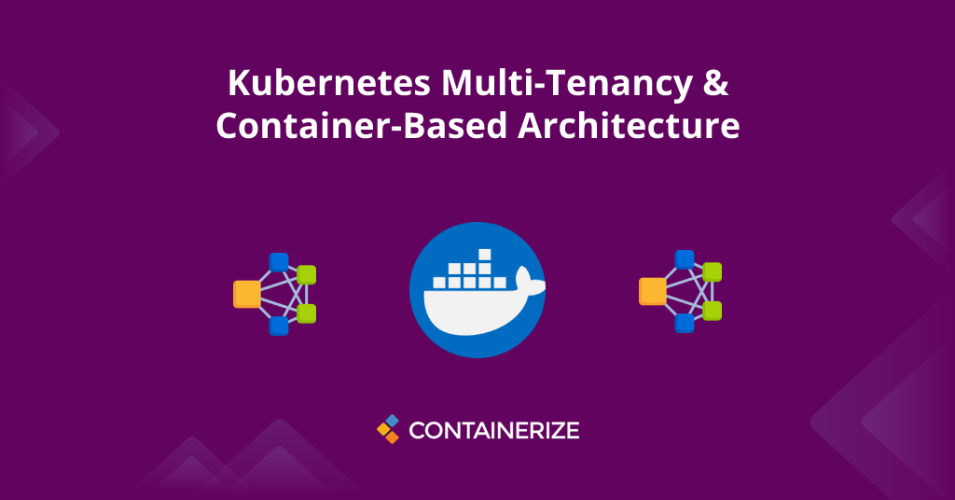Kubernetes cluster resources are shared among all tenants. Implement Multi-Tenant container hosts approach to deploy optimized and resource-saving applications.

Kubernetes Multi-Tenancy & Container-Based Architecture
Overview
We are here with another exciting blog post in the series of multi-tenancy. In our previous article, we touched on the basic concept behind multi-tenant apps, the pros, and cons, and the types of multi-tenant architecture. Since it is high time to serve multiple users/tenants, manage and utilize resources in an efficient way. So, multi-tenancy is the top approach to building an infrastructure that handles various clients/tenants simultaneously. However, our most recent blog post demonstrated serverless architecture, containerization, and Kubernetes. Therefore, in this article, we will explore multi-tenancy & container-based architecture. In addition, we will see how you can achieve multi-tenancy in your containerized apps.
The following points shall be covered in this article:
Multi-Tenant Container Hosts
Multi-tenant application deployment is a critical task when it comes to hosting platforms. You all know that containers are lightweight compared to Virtual Machines. Application deployment takes only a few milliseconds to complete the deployment whereas, it could b a matter of seconds to minutes in the case of Virtual Machines.
However, achieving multi-tenancy in a container-based architecture is quite straightforward. Every tenant is hosted by a separate container with complete isolation and data privacy. That means the number of containers depends on the number of tenants. Further, the following tools will be used to achieve this approach:
- Docker and Docker Compose
- Nginx
- Database instance
- Application Server
You will use Docker to build the image which is a template to build the container. In addition, you will use Docker Compose to spin up multiple container hosts. Moreover, you will use Nginx to redirect the incoming requests to the proper tenant. So, every container host contains the application and database instances up & running. This multi-tenant container hosts method is not resource-intensive and offers robustness in managing various tenants and making sure data isolation and security.
Kubernetes Multi-Tenancy
Kubernetes contains many components in its architecture such as Nodes, Cluster, Control plane, and more. Basically, there is no built-in multi-tenancy in Kubernetes but you can achieve it. So, there are multiple applications/tenants running and sharing the Kubernetes cluster and control plane. On the other hand, in single-tenant apps, a single instance of the application occupies the whole Kubernetes cluster.
Moreover, going a little deeper will make us learn about tenant hosting in the Kubernetes cluster. Every tenant is associated with a Kubernetes namespace that organizes code and prevents name collisions. There are three approaches to achieving multi-tenancy in Kubernetes. The first is Namespace as a Service, the second is Cluster as a Service, and the third one is Control Planes as a Service.
Fairly speaking, Kubernetes multi-tenancy offers a cost-effective solution to the organization dealing with multiple user interfaces. In fact, you can face some challenges such as user management and better resource management. Nevertheless, it totally depends on the use case and the nature of the application you are aiming for.
Conclusion
This brings us to the end of this blog post. We have gone through Kubernetes multi-tenancy & container-based architecture for achieving multi-tenancy. In addition, there are many third-party libraries available to bridge the multi-tenant apps with Kubernetes. This blog post will help you in understanding the concept of multi-tenant container hosts. There are other interesting blog posts that you may find in the “See Also” section.
Connect with us
Lastly, containerize.com offers ongoing blog posts on various open-source products and topics. You can stay in the loop by following us on our social media platforms, including Facebook, LinkedIn, and Twitter.
Ask a Question
You can let us know about your questions or queries on our forum.
FAQs
What is multi-tenancy in Kubernetes??
Follow this link to know Kubernetes multi-tenancy.
What is a multi-tenant vs single-tenant cluster?
In a multi-tenant cluster, all the tenants/clients share the Kubernetes cluster whereas, in a single-tenant cluster, there is one separate cluster running for each tenant.
See Also
- What is Serverless Computing? | Serverless Architecture
- What is Multitenancy? | Why a Multi-Tenant Approach?
- What is Generative AI | Generative Artificial Intelligence
- How to Integrate ChatGPT with Google Sheets
- How to use ChatGPT in VSCode | The VSCode Extension Code GPT
- What is OpenAI Chatbot GPT-3 | ChatGPT an AI Revolution
- An Introduction to Artificial Intelligence | What is AI?